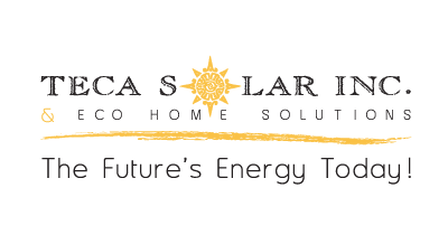Solar PV Panel Installation
Professional Installation available in South Florida and The Bahamas
Save Money and Be Energy Independent
All solar systems differ and their efficiency varies. PV systems are multi-crystal, single crystal, or amorphous, usually thin film. There should be serious consideration when making choices about the system that's right for you. Most single and multi crystal modules equal in efficiency. Thin film and roof tile panels, panels are not as efficient, but unlike traditional panels, these panels have the advantage of being able to perform in overcast conditions.
Requiring no fasteners or penetrations to your roof, thin film PV systems may seem like a more attractive choice. Keep in mind that with the choice to use thin film PV you may lose between 4% to 6% efficiency because of the roof's heat and the peel and stick method implemented with this system. We at Teca Solar recommend and prefer modules due to their overall efficiency.
On or Off Grid Solar Electric.
On and Off-grid solar systems operate from the stored energy in a battery bank
If you are looking for energy efficiency, Solar Electric (PV) is the right system for your home or business. Most common sizes are the 5kW or 10kW PV system. If whatyou need to save more we recommend to extend other solar solutions such as Domestic Solar Water Heater, Solar Pool heater and High Efficiency Variable Speed Pool Pump. The initial expense can be offset by the existing 30% Federal tax rebate that is currently available.
MonoCrystalline Panels
Advantages
Monocrystalline solar panels have the highest efficiency rates since they are made out of the highest-grade silicon. The efficiency rates of monocrystalline solar panels are typically 15-20%. SunPower produces the highest efficiency solar panels on the U.S. market today. Their E20 series provide panel conversion efficiencies of up to 20.1%.[3]Update (April, 2013): SunPower has now released the X-series at a record-breaking efficiency of 21.5%.
Monocrystalline silicon solar panels are space-efficient. Since these solar panels yield the highest power outputs, they also require the least amount of space compared to any other types. Monocrystalline solar panels produce up to four times the amount of electricity as thin-film solar panels.
Monocrystalline solar panels live the longest. Most solar panel manufacturers put a 25-year warranty on their monocrystalline solar panels. These tend to perform better than similarly rated polycrystalline solar panels at low-light conditions.
Disadvantage
Monocrystalline solar panels are the most expensive. From a financial standpoint, a solar panel that is made of polycrystalline silicon (and in some cases thin-film) can be a better choice for some homeowners.
If the solar panel is partially covered with shade, dirt or snow, the entire circuit can break down. Consider getting micro-inverters instead of central string inverters if you think coverage will be a problem. Micro-inverters will make sure that not the entire solar array is affected by shading issues with only one of the solar panels.
The Czochralski process is used to produce monocrystalline silicon. It results in large cylindrical ingots. Four sides are cut out of the ingots to make silicon wafers. A significant amount of the original silicon ends up as waste.
Monocrystalline solar panels tend to be more efficient in warm weather. Performance suffers as temperature goes up, but less so than polycrystalline solar panels. For most homeowners temperature is not a concern.
PolyCrystalline Panels
Advantages
The process used to make polycrystalline silicon is simpler and cost less. The amount of waste silicon is less compared to monocrystalline.
Polycrystalline solar panels tend to have slightly lower heat tolerance than monocrystalline solar panels. This technically means that they perform slightly worse than monocrystalline solar panels in high temperatures.
Heat can affect the performance of solar panels and shorten their lifespans. However, this effect is minor, and most homeowners do not need to take it into account.
Disadvantages
The efficiency of polycrystalline-based solar panels is typically 13-16%. Because of lower silicon purity, polycrystalline solar panels are not quite as efficient as monocrystalline solar panels.
Lower space-efficiency. You generally need to cover a larger surface to output the same electrical power as you would with a solar panel made of monocrystalline silicon. However, this does not mean every monocrystalline solar panel perform better than those based on polycrystalline silicon.
Monocrystalline and thin-film solar panels tend to be more aesthetically pleasing since they have a more uniform look compared to the speckled blue color of polycrystalline silicon.
Florida Solar Energy Center
An efficient, cost effective PV system (5 - 10kW) can represent a savings of about $80 to $180 a month. That could mean $1,000 - $2,200 over the course of a year!
The main things to concider when buying a PV system are, the total electric bill reduction, and the pay off time that system will provide.
In relation to what people pay in other parts of the world for electricity, at today's prices, our electricity is comparably inexpensive. Our electricity costs will certainly rise in tomorrow's climate and trend of rising costs for fuel and electricity.
Energy independence makes sense on many levels, especially financially. "As the global community grows, so does the need for energy. " - Florida Solar Energy Center.
Solar Adjuster Services
If you Need Help with any Solar Related Concern or Damage, We provide Professional Evaluation for:
- Insurance claims
- Warranty claims In case, your Contractor did not installed the system the way it should have been done..
Solar PV Panel Installation - Coral Springs, Parkland, Boca Raton, Weston, Broward, Dade, Miami, Jupitar and The Bahamas
Helpful links...
US Department of Energy
Sunshot Initiative
American Solar Energy Society
Solar Electric Power Association
National Renewable Energy Laboratory
Solar PV Electric System Calculator





